What
gave Sparta an advantage over other Greek States between
500-390BC and Persia during the Persian Wars?
.........Between
736 to 545.BC, Spartan influence in the Peloponnese was established
and fortified; a series of battles took place with their
neighbours, namely the Messenians who became an irreplaceable
element to their economy as serfs or Helots. The helots (hel
meaning seized in Greek) were the key to the future military
might of Sparta, the whole Spartan social and economic system
was based on their subservience, and they could never have
become professional soldiers without them. The Second Messenian
war (668-657.BC) further hardened their need for vigilance
and a strong force to keep the population under control.
Throwing the control of Sparta off them, they rose up and
were quashed over a 10-year period that created paranoid,
aggressive and far more vigilant Spartans.A series of defeats
with Tegea and Argos, their neighbours in the Peloponnese,
pushed Sparta to developing a system of training Hoplites
so they could defeat these defiant neighbours. Lycurgus,
the law giver, began his Great Rhetra during this period,
a system that the Spartans craved for according to ancient
source but already had in working practise, laws to refine
their citizen-soldiers into effective fighting men and moulding
every other aspect of Spartan life around the hoplite.
|
 |
Chigi Vase 650.BC.
First piece of archaeological evidence showing a hoplite
phalanx formation.
|
|
.......The
Spartan military was Sparta, Spartan citizens where either
soldiers, children training to be soldiers or women; nothing
like this was ever seen through Greece at this time. They
had no love of democracy, art or other pleasures as simple
as an exotic meal. In Plutarch’s ‘Sayings of
Spartans’ King Agesilaus is asked what Lycurgus’ best
gift was to Sparta, the reply ‘contempt of pleasure.’ This
was the whole ethos of Sparta, not even newborn babies were
safe from this system that served to better Sparta’s
military power. The Tayegetus Gorge was sited as the place
where the Ephors rid Sparta of ‘imperfections,’ archaeology
in this area has found many skeletons confirming this myth.
After the weeding out of ‘defects’ and a time
at home being left in the dark to promote excellent vision
for night, the young Spartan at 5 years old would enter the
Agoge and pass out at 30 year old a full homoio, a spartiate
citizen and liable for duty. The Paidion (Boy) would go through
training that covered military dances, evasive manoeuvres
that were used in battle, Tyrtaios’ songs and poems
to harden their spirit and make them patriotic, pack rivalry
to make them more competitive and even reading and writing
which would be accompanied with Laconic Rhetoric enabling
the Spartiates to not only defend themselves in battle but
defend themselves in debate. At 12 years old (Meirakion stage)
they went barefooted, feed a minimal diet of black broth,
Plutarch claiming it was basically an acquired taste as the
old men only ate it, and put them under the guidance of an
older spartiate who trained them in more battlefield orientated
practises. At 18 years old if successful they entered the
mess system and became a hardened team member, this taught
loyalty and companionship to one another as soldiers. ‘With
it or on it’ [Hoplon shield] as Plutarch puts it was
the motto of the Spartan hoplite that needed the man to the
right at all times. At 28yrs, they entered the Kryptaea,
secret police with parallels to that of Soviet Russia’s
KGB, policing the helot population with no concerns about
killing them as an act of terror and discouraging any unrest
or attempts at rebellion.
|
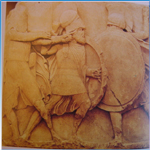 |
Neried Frieze
showing the Hoplon shield's importance to a Holpite
|
 |
540.BC Vase
showing Hoplitodromos.
|
|
........At
30 years old the Spartiate warrior had the advantages of
training, a hardened, physically strong body and an education
that only few in Athens had. Athens, one of Sparta’s
main rivals, had a very basic training system for Hoplites
that started at 18 years old and lasted two years. One such
training method was employed as an Olympic event but used
at Marathon by the Athenians, the Hoplitodromos or Hoplite
Run which was developed especially for attacking Persians
through an missile (arrow) shower and was mentioned by Herodotus
as double paced marched to the Persian line at Marathon.
The Spartans certainly knew of this, they seem to have had
an employed a moving defence at Thermopylae to avoid Persian
archery. There is a far more effective weapon in war than
a shield and spear as The Battle Of Sepea proved in 494.BC.
The Psychological affect of Sparta’s military reputation
led the Argives to blunder over concerns they would be ‘caught
out by some trick’ [Herodotus]. This lead to the Argives
mimicking every order they heard that was issued to the Spartan
hoplites, the Spartans obviously figuring this out called
for breakfast and attacked, catching the Argives with absolute
surprise. Sparta’s reputation alone had almost won
The Battle Of Sepea, ending the threat to Sparta.
|
|
| .......Another,
smaller advantage it had as a city-state was its early dominance
of the Peloponnese through a unilateral alliance know as the
Peloponnesian League. Their allies, such as the Tegeans and
Corinthians joined early and saved the Spartans from warring
on and having to add more subjugated people to its helot list,
a list which out numbers them heavily and did not need adding
to. So, Sparta gained its reputation by fighting neighbours
and other states through out the Peloponnese, something that
moulded their foreign policy and made them reluctant to face
the Persian as they advanced through Attica. When actually
forced to leave the Peloponnese they had the advantage of being
able to command other Peloponnesian allies to join them such
as Corinth and most especially Tegea who always fought beside
them in the Phalanx. The Peroiki, a trade and crafts tier to
their society, always provided Hoplites and helots, brought
mainly through paranoia, formed the light infantry which could
be very useful as they were “armed for war” [Herodotus].
King Agesilaus also explained why Sparta had no walls unlike
most Greek city state, his explanation was that ‘The
walls of Sparta were it’s young men, and it’s borders
the points of their spears’ [Plutarch], archaeological
finds at Sparta found the original palisade wall around the
inner 5 towns that made up the city but no fortified stone
walls have ever been found. This is a good explanation of why
Sparta was reluctant to fight out side the Peloponnese with
it’s shy foreign policy, it was effectively a defensive
army keeping a nervous eye on the helots and defending it’s
self aggressively from neighbours like the Argives, giving
the army a psychological advantage over other defenders like
the Athenians in the Peloponnesian war who were frightened
to come out from the walls to engage the Spartans. Again using
Thermopylae as an example, instead of defending the wall the
Spartan stood infront of it, King Leonidas opted to form a
phalanx to oppose the Persians, and this seems to indicate
an aggressive form of defence. This does make sense when linked
with the fact that a static target was far easier for the Persian
archers to bombard, the logic of this move seen when the Spartans
took up a static position on a hillock for their final stand,
an array of Persian arrows ending the Spartan stand at Thermopylae. |
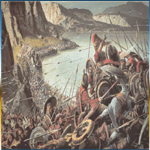 |
An
Approximation of Thermopylae
|
|
.......By
the time of the Second Persian War in 480, the Spartans had
built up a formidable reputation for being professional soldiers
and had army organisation down to an art form. Most states
employed the Lochoi and enomotiai system but the Spartans had
a more flexible and refined system, similar to that of the
Persians. Herodotus detailed much about the Spartan army with
a very important later edition of the Mora coming from Xenophon,
it is believed that it existed early on though as it would
have made tactical sense to split the whole army into large
division rather than have the King as supreme commander of
6500 to 9000 Spartiates and then the nearest available sized
unit to be around 500 to 600 men.
Unit
|
Commanded By
|
N.o in Superior
unit
|
N.o of Men
|
Mora
|
Polemarch
|
6/7 made
whole Army
|
1000+
|
Lochoi
|
Lochagoi
|
2
|
500+
|
Pentekostyes
|
Pentekonteres
|
4
|
120+
|
Enomotiai
|
Emonotarchs
|
4
|
30-40
|
After the Othismos (Shoving)
stage of the battle, when the Phalanxes meet with the collision
of the two shield walls, the strategies of the commanders
were in full motion and could not be changed. However,
the Spartan army with its complex chain of command and
internal groupings, could play out set manoeuvres after
the shield walls meet, giving them a great deal of adaptability
if any unforeseen enemy action took place. This advantage
was the most precious to the Spartans, they had to fight
together and trust the judgement of their superiors because
they would fall in battle on there own as their enemies
often did in disarray. Exiled King Demaratus, when asked
to fight 10 Immortals on his own to prove Spartan superiority
over the Persian, he replied to Xerxes ‘fighting
singly the Spartans are no worse than other men, but together
are the best of all mankind’ [Herodotus]. An excellent
example of their ability to change strategy mid-battle
was displayed at the First Mantinea 418BC. According to
Thucydides, when the Spartan left collapsed and fled letting
the enemy right flank in to loot the Spartan baggage train,
the Spartan king managed to use his right-flank to chase
the enemy left and pivoted around to his own left to catch
the returning enemy right wing totally by surprise and
wining the battle. This just showed the organisational
skills of the Spartans through even the most confusing
battles, turning a disadvantage around quickly to become
an advantage that won the battle.
|
|
| .......Spartan
society also added itself as an advantage as everyone followed
the Great Rhetra instructions. Women gained equal rights to
men in many respects, mothers being the most respected in all
of Sparta for bringing a new generation of male warrior into
Sparta. Women had a psychological effect on many Spartans,
their mothers giving them the rhetoric they needed to hear, “with
it or on it” being one such comment. Women could even
publicly mock men, who had no children or were proven to have
shown cowardice in battle, with no fears about the men answering
back as many were sharp tongued, they too trained in Laconic
Rhetoric. Some scholar’s blame the low Spartiate population
on the freedom the system give women and the late age in which
they were allowed to marry, but homosexuality was one of the
other elements that kept population levels down. Xenophon being
a Lacaedominophile (Spartan Fan) claims homosexuality was thrown
upon as many in the Greek world knew it existed but thought
of it as a Taboo, this simply wasn’t true as it was a
common practise of the Agoge. The position of ???????, who
looked after a paidion in the Agoge, actually meant ‘Lover,’ King
Agesilaus and Lysander being the biggest example of this form
of relationship. While homosexuality was more or less forced
on the Agoge trainees, it was made clear that they had to produced
children or face losing their rights, this produced mainly
bisexual Spartans that had both a military advantage and a
social advantage. Women were married and children born through
fear of humiliation, but at the same time a Spartan was not
just fighting for himself, his country and a host of other
soldier next to him, his was fitting for a lover or a friend
from the mess system creating a very strong bond and a person
to defend on the actual battle so they would not run off and
think later upon what they had done. |
|
| .......The
Persian use of levy troops also helped to boost the numbers
they had in the field but quite realistically they were not
a strong skilled team like the Spartans were. Herodotus’ ‘Catalogue
of Nationalities,’ which comments on all the levy troops
Xerxes brought, gives a rough idea on how the nationalities
were so ill-equipped that they would have been slaughtered
fighting a phalanx. The vase below helps confirm Herodotus’ claim
that Aethiopian marines joined the land army at Plataea when
the Athenian navy sank their ships at Salamis. Some levy troops
like Arab Camel archers, Indian footmen and war elephants certainly
had a psychological effect on some Greek contingents but the
Spartans were not impressed as it was a show by Xerxes, many
either didn’t want to be their or were ill-equipped making
them easy prey for the Spartans. The Persians themselves, a
mix of Mede and Persian citizens were well trained in archery
and javelin use from their early days as herdsmen trying to
protect there cattle from wolves and other predators. Persian
cavalry however was seen as one of the worlds finest, skilled
enough to fire a bow while riding the horse at full pace, ‘being
horse-archers, they were very difficult to get at.’ [Herodotus]. |
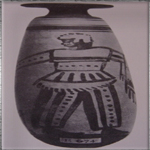 |
Part of an
Athenian Vase Collection, "Negro Alabastra
|
|
| .......The
Battle of Plataea in 479BC was the last of the Persian invaders,
a strong hold that needed to be taken. Many have questioned
what actually went on at Plataea during the night when every
Greek contingent moved. The Greek units were prompted to
move because of Persian cavalry attacks, the Megarians nearly
had there whole force annihilated but were reinforced by
Athenian hoplites and archers who saved them and hit Masistius
(Persian Cavalry leader) which brought him to the ground
and subsequently his death. Greek cavalry was almost none
existent so hoplites always feared a cavalry unit could quickly
flank them and attack there exposed lines. As the picture
to the right shows, Persian cavalry was not refined enough
to take on a prepared hoplite who had a far longer spear
unlike the cavalry man who had an exhaustible weapon in the
form of a javelin and no stirrups to hang on to the horse,
meaning charges were impossible. This fact, coupled with
the fact the Myriad (10,000 strong cavalry – Herodotus)
had lost their beloved leader, Masistius, did not play any
further role at Plataea except to cover the retreat of the
Persian infantry. The nighttime blunder was an incident with
Pausanius (Spartan General) who did not want to move his
unit, against the wishes of the present Ephors (Spartan overseers),
delaying many attached Greek units and causing disorganisation.
When morning came the Greek contingents were scattered all
over the area, some were near to the mountain range and some
well a head on the plains. Many scholars have debate whether
this was a cunning strategy the Spartans had planned for,
just like the Battle Of Sepea. Herodotus claims it was a
blunder averted only by luck but he may not have understood
the depth of planning. This drew out the Persian commander,
Mardonius who ordered a missile bombardment of the upcoming
Greeks. The Spartans and Tegeans made the first surge forward
and brought the Spara down, ripping into the Persians and
into the camp, winning the battle. |
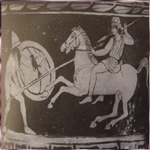 |
Italian Red
Figure Calyx Crater 440 B.C. A Spartan against an Eastern
Cavalry Man
|
|
| .......The
Spara was Persia’s answer to a shield wall, sometimes
literally acting as a wall. The Spara was a full-length shield,
leather reinforced with osiers (similar to wicker), its modern
equivalent being something like a police riot shield. Herodotus
and especially Xenophon commented on Persian organisation in
which they describe the role of the Dathapatis, commander of
himself and nine behind him in a line (Dathabam), and ten lines
to make sataba that consisted of one hundred. The Dathapatis
would hold the Spara and use the 1.8m length spear to keep
back any attacker who got close enough while the nine in his
formed line used their bows and rained arrows down, hitting
any incoming forces. The development of aggressive tactics
by the Greeks such as the Hoplitodromos, the aggression of
the Spartans and Tegeans at Plataea and the fact the Greek
hoplite carried a 2.4m spear, gave the Spartans a huge advantage
over the Persians who simple didn’t have the weaponry
to combat the hoplite. |
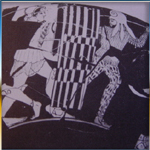 |
An Achaemenid
Persian Spara on an Attica Vase fighting a Hoplite
|
|
|

